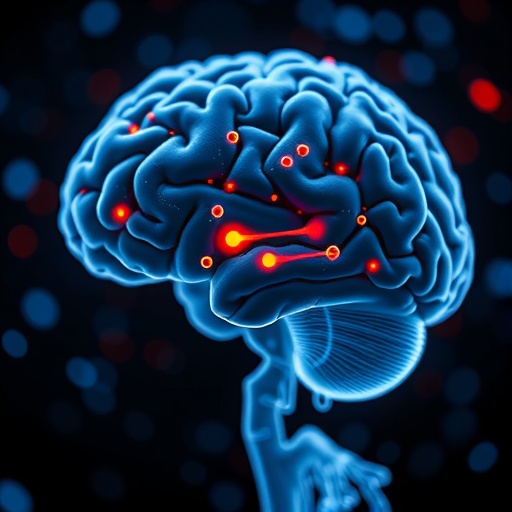A groundbreaking study published in the reputable journal Aging-US has uncovered pivotal insights into the relationship between age and amyloid positivity in Parkinson’s disease (PD) patients who have not yet developed dementia. This research, conducted by a team led by Keiko Hatano with senior correspondence by Masashi Kameyama at the Tokyo Metropolitan Institute for Geriatrics and Gerontology, provides critical new evidence on how amyloid-beta accumulation varies with age in a PD population, offering profound implications for early diagnostic strategies and therapeutic interventions.
Parkinson’s disease is primarily recognized as a motor disorder caused by the loss of dopaminergic neurons in the brain. However, non-motor symptoms, particularly cognitive decline and dementia, are increasingly acknowledged as significant challenges faced by patients. Amyloid-beta peptides, especially Aβ42, have long been established as molecular hallmarks of Alzheimer’s disease (AD), involved in pathological plaque formation. Yet, their involvement in PD, particularly in the early stages before overt dementia manifests, has remained an enigma.
The researchers embarked on a meticulous analysis of cerebrospinal fluid (CSF) biomarkers in a cohort of 89 Parkinson’s patients without dementia, stratifying participants into two distinct age brackets based on age at diagnosis: those younger than 73 years (the LOW group) and those 73 years or older (the HIGH group). By employing gold-standard assays to measure CSF Aβ42 concentrations, alongside phosphorylated tau (p-tau) and total tau (t-tau) proteins—both critical markers implicated in neurodegenerative processes—the team delineated age-associated trends in amyloid pathology within PD.
Their findings revealed a pronounced elevation in amyloid positivity among the older PD subgroup, with 30.6% testing positive for amyloid pathology compared to a mere 10% in the younger cohort. This sharp increase underscores an intrinsic age-dependency of amyloid accumulation within PD, suggesting that patients diagnosed at an advanced age may harbor latent neuropathological processes predisposing them to cognitive decline. Intriguingly, no participant exhibited clinical dementia, indicating that amyloid accumulation may precede or predict subsequent cognitive deterioration.
Delving deeper into the biomarker dynamics, the study employed Pearson’s correlation analyses to explore the relationships between age at diagnosis and CSF biomarker concentrations. A negative correlation trend was found between Aβ42 levels and age, aligning with the hypothesis that amyloid burden escalates with advancing age. Conversely, significant positive correlations emerged between age and both p-tau and t-tau levels, biomarkers reflective of neurofibrillary pathology and neuronal damage respectively, thereby reinforcing the complexity of neurodegenerative cascades intersecting in these patients.
Interestingly, the authors compared amyloid positivity rates between PD patients and cognitively normal individuals in the general population within matching age strata. Contrary to expectations, PD patients demonstrated a lower prevalence of amyloid positivity than age-matched controls without PD. This counterintuitive finding challenges traditional paradigms and suggests that Parkinson’s pathophysiology may modulate amyloid deposition kinetics or clearance differently, potentially abbreviating the asymptomatic window of amyloid buildup prior to clinically evident dementia.
These novel insights prompt important clinical considerations. Given the burgeoning global incidence of PD, especially among older adults, early identification of patients at risk for cognitive decline is paramount. The pronounced amyloid positivity in elderly PD patients without dementia underscores the need for preemptive screening using CSF biomarkers or analogous imaging modalities. Such strategies could foster timely interventions before irreversible neurodegeneration transpires.
Moreover, the clinical implications extend into therapeutic development. Amyloid pathology has been a focal point in Alzheimer’s research, but its role in Parkinsonian cognitive decline is gaining prominence. This study suggests that amyloid-targeting therapies, perhaps in combination with agents modulating tau pathology, could represent promising avenues to delay or prevent dementia in PD, especially for older patients exhibiting biomarker evidence of amyloid accumulation.
Equally compelling is the study’s contribution to mechanistic understanding. The observed associations between increasing age and rising p-tau and t-tau levels hint at converging pathological pathways shared between PD and AD. This overlapping molecular signature raises questions about shared neurodegenerative processes and potential points of therapeutic convergence in treating mixed pathology syndromes.
Given these intricate biomarker interplays, future research should investigate longitudinal trajectories of amyloid, tau, and other neuropathological markers in PD cohorts, ideally integrating multimodal imaging and fluid biomarker analysis. Prospectively tracking cognitive outcomes alongside biomarker changes could illuminate causal relationships and identify critical intervention timepoints.
The researchers also carefully noted their findings within the framework of AT(N) biomarker classification, a system categorizing Alzheimer’s-related neuropathology based on amyloid (A), tau (T), and neurodegeneration (N) markers. Significant positive correlations specifically appeared in the AD continuum category but not uniformly across all groups, highlighting the heterogeneity of neuropathology among PD patients and the necessity for tailored diagnostic algorithms.
This comprehensive investigation was conducted without conflicts of interest, ensuring unbiased results, and was disseminated open access to maximize scientific and clinical reach. The meticulous methodology and robust statistical analysis employed lend credence to the findings, which are poised to influence both research and clinical practice.
As the landscape of neurodegenerative disease research evolves, this study shines a spotlight on the intricacies of amyloid pathology within Parkinson’s disease absent dementia. It underscores the necessity for age-conscious approaches in assessing neurodegenerative risk and paves the way for innovative disease-modifying strategies that may ultimately improve patient outcomes.
In summary, the intersection of amyloid biology with Parkinson’s disease pathology remains a fertile ground for exploration. The findings from this study provide a critical foundation for understanding how age shapes neurodegenerative trajectories and reinforce the urgency of early biomarker-driven interventions to combat cognitive decline in PD populations worldwide.
Subject of Research: People
Article Title: Age-related trends in amyloid positivity in Parkinson’s disease without dementia
News Publication Date: August 6, 2025
Web References:
Image Credits: © 2025 Hatano et al., licensed under Creative Commons Attribution License (CC BY 4.0)
Keywords: aging, amyloid positivity, Parkinson’s disease without dementia, cerebrospinal fluid Aβ42




